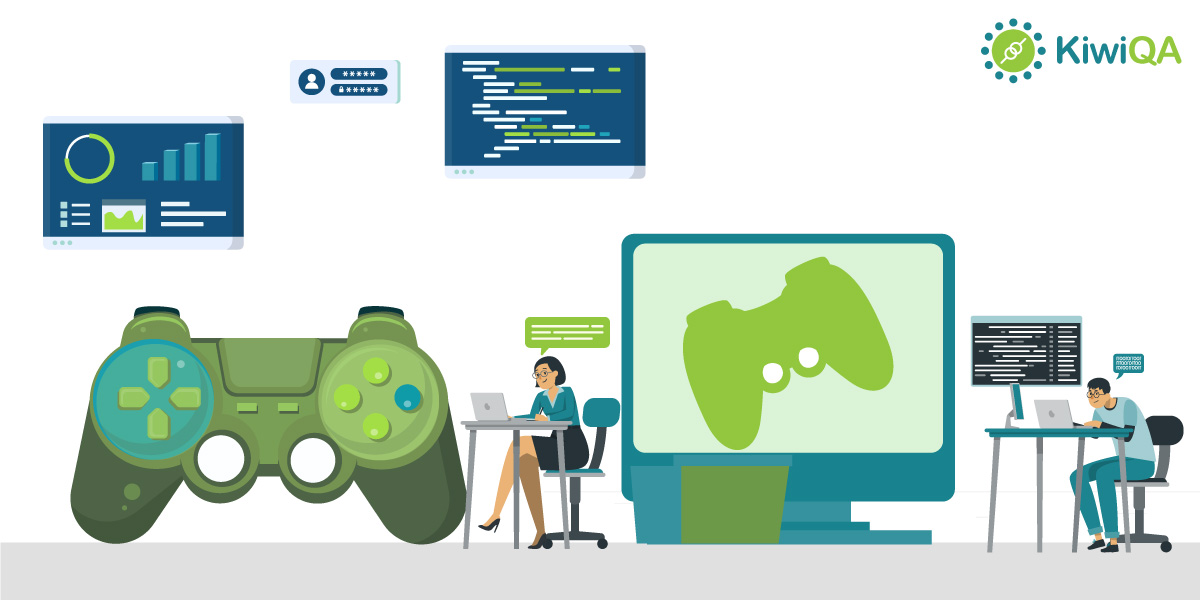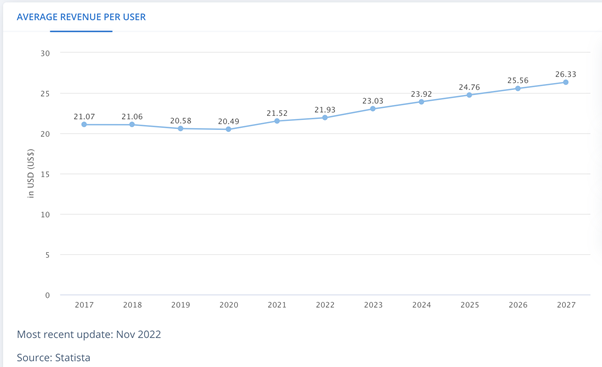Online gaming has gone through tremendous changes since the introduction of high-performing smartphones. Before the smartphone era, gaming enthusiasts only had the option to play games on Xbox, PlayStation, etc. Now gaming companies have the privilege of releasing single-player and/or multiplayer games for a range of devices i.e. laptops, desktops, mobiles, tablets, etc.
As per reports[1], the revenue from online games is expected to reach $26.05 billion in 2023. The number of gaming users is expected to amount to 1,252.6 million by 2027. The stickiness factor of any online game depends a lot on game logic, graphics, and prize money.
Average Revenue Per User (ARPU)
What if these factors are let down due to bugs in the games? Online games are different from other online applications, since most games are intensive on the CPU and GPU fronts. In most of the games, CPU handles the game logic whereas GPU handles rendering of the frames on the screen.
The GPU and CPU speeds will keep on throttling depending on the workloads. Thermal throttling protects the device from being overheated, during which you might experience frame lags as well.
As a game developer, you might not be able to control the speeds at which the device operates, but you can invest in testing the game on supported device combinations. Like any other form of software, games also must be tested at every stage of development.
If you are building mobile games, you need to prioritize testing on real devices over testing on emulators/simulators. You also need to prioritize the test types so that it leads to game improvement from all the aspects. In this blog, we deep dive into the different forms of game testing. We will also cover how a mobile game testing services company can help in getting the maximum ROI from testing.
What is Mobile Game Testing?
In simple terms, game testing on mobile devices is a QA process whereby the corresponding game is tested on different devices. Owing to the device and OS fragmentation, it is nearly impossible to test the games on all the available devices. Hence, the devices for testing must be selected depending on the target market in which you plan to release the game.
For instance, Android developers add the following information in AndroidManifest.xml:
- App components
- Device compatibility
- Intent filters, and more
Since the list of supported devices is in the hands of the developers, it becomes somewhat easy to choose the ones on which you want to run tests on priority. However, that is not the end of the story! You also have to make a wise and long-term decision on testing on local real devices or a cloud device farm!
As game testing is a continuous process, you should look into CI/CD tools (e.g. CodeMagic[2]) that lets you run continuous tests in a CI/CD pipeline. This ensures that your game is tested whenever any fix/feature is pushed into the repository.
Forms Of Game Testing
Before we deep dive into the game testing types, let’s try to answer the integral question – What tests should you focus on for improving the game quality? The simple answer to this question is “Prioritize the tests depending on the game logic, game type, and leaderboard logic in the same”.
Now that the platform is set, let’s look at some of the major forms of mobile game tests:
1. Functional Testing
Like any other form of software, it is essential to invest heavily in testing the functional aspects of the game. Most of the mobile games come with social media integration so that the players can share their scores with their online connections. Though this sounds like a trivial feature, it plays a key role in long-term retention. It also contributes to the virality of the game.
All the screens that are a part of the game play must be tested thoroughly on the supported mobile devices. You should also test the game on devices with different CPU & GPU configurations so that you can gauge the game’s performance. This test will also be useful in correcting the game logic in case the game’s performance is not up to the mark on certain category of devices.
Since a majority of the games are highly intensive, the tests should also log the CPU, GPU, thermal temperature, and RAM usage during the process of testing (Source). On the whole, functional tests must be considered at every step since the game’s success depends on a lot on the same!
Also Read: Best Practices of Mobile Game Testing
2. UI Testing
A lot of games like Call Of Duty, Minecraft, Pokémon GO, etc. are available for mobile, tablets, as well as desktops. This strategy is used by many game developers since it helps increase the reach of the game. As the game is available for devices with different screen sizes, you need to test the game logic thoroughly on them.
While testing on emulators and simulators are good to start with, testing on real devices must be a part of every release. Functional and UI testing on real device cloud could reap significant benefits in the long run. Automated frameworks like Appium should be leveraged for running tests at scale. UI and functional tests must be a part of the CI/CD pipeline so that untested code does not make way into the release.
Onboarding a mobile game testing services company can help you make the most of the respective testing strategy and infrastructure used for testing the gaming app.
3. Performance Testing
Like any other form of application, mobile games can also be developed using the hybrid or native approach. Though the choice depends on the development team, the fact is that there should be no degradation in its performance when subjected to heavy load.
Also, game developers use cloud gaming infrastructure for flexible app distribution and enabling cross-play across different form factors (Source). Usage of payment gateways, social media integrations, cloud resources, etc. are mostly a part of every mobile game.
All of this when integrated must be tested on real devices, on varying load and traffic levels. This helps in building a more robust and responsive application. At the same time, it also improves the test and device coverage thereby ensuring that the game performs well on the targeted devices!
Performance testing of mobile games ensures that the game performance is always up to the mark, even when a large number of concurrent users are playing the game.
Also Read: Complete Guide To Game Performance Testing
4. Interrupt Testing
We all know how many interruptions (e.g. SMS popups, battery alerts, etc.) can occur when using any mobile application. During such cases, the context is switched from the current application to the other application that has caused the interruption. For instance, low battery or temperature alerts on a mobile device prompts you to take actions for handling the condition.
The mobile gaming application must be robust enough for handling such interruptions, without causing any performance or experience degradation in the game. What happens in the game if there is a temporary network loss or what happens if the network switches from 3G→4G or vice-versa.
The game logic should be able to cater such dynamic situations without impacting the end-user experience. This is why interruption (or interrupt) testing becomes an absolute necessity for mobile games.
Apart from these tests, you should also focus on cross browser compatibility tests for verifying the scenarios (e.g. login, social media sharing, etc.) where the respective web browser is used for completing the operation.
Lastly, you need to keep a continuous watch on Google Lighthouse reports for auditing the page and app performance under different CPU and network throttling conditions.
Also Read: Detailed Mobile Game Testing Checklist
Conclusion
Game developers must weigh development and testing equally, as it helps in improving the quality and robustness of the game. This is where an integrated game testing strategy can be super useful as it aids in testing every aspect of the mobile game.
Most games follow the freemium strategy for building the virality in the game. Hence, it is recommended to thoroughly test the integration with different payment and Ad providers since it eventually contributes to the revenue generated from the game.
Onboarding an experienced game application testing services company like KiwiQA will help you in reducing the time-to-market and improving all the aspects of game quality. All of this will lead to maximization of gaming revenue and improving the key metrics (e.g. ARPU, DAU, AMU, Installs, Retention Rate, Churn Rate, stickiness, Lifetime Value) of the game.








